Top News
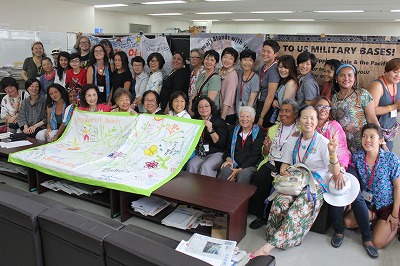
June 27, 2017 Ryukyu Shimpo
On June 26, the International Women’s Network meeting against Militarism in Okinawa 2017 has issued a statement demanding the cancellation of construction of U.S. military helipads in Takae, Higashi, the new base in Henoko, Nago and a live-fire training range in Guam. The meeting is organized by women in countries and regions hosting U.S. military bases.
Okinawa Women Act Against Military Violence co-representatives Suzuyo Takazato and Keiko Itokazu, and participants of the international meeting expressed resolve to work to build peace and justice without relying on militarism, and to gain gender equality and a sustainable future, at a press conference held at the Okinawa Prefectural Government office on the same day.
The statement will be sent to Prime Minister Shinzo Abe, President Trump and the heads of the home countries and regions of the participants, as well as international organizations such as the United Nations.
The statement demands the withdrawal of the deployment of the Terminal High Altitude Air Defense (THAAD) missile defense system to South Korea. It also calls on the governments of the United States and the countries and regions hosting U.S. military bases to apologize to women involved in the sex industry around the bases.
Its main theme centred around “Issues involving the violation of the rights of indigenous peoples and sexual violence by military, which have been looming.” The organizers said the situation of culture and nature being destroyed around military bases was extremely serious.
(English translation by T&CT)
Go to Japanese
June 26, 2017 Ryukyu Shimpo
Special Correspondent Yukiyo Zaha reports from Washington D.C.
The perception of troops in the United States is markedly different from the perception in Japan. Reports by the U.S. government and by television programs concerning military interventions in the Middle East and elsewhere color these actions as: “The American troops fighting for justice in order to protect our country.” As such, servicemen and veterans are admired. However, homeless ex-soldiers can be found on street corners holding signs bearing the words “I am a veteran” and begging for change.
In any country, in any era, the common people fall prey to politically fueled wars. While thinking back on images of people running to escape bombings and internally worrying about the present state of the military industrial complex, I met to speak with Steve Rabson, professor emeritus of East Asian Studies at Brown University. Rabson’s op-ed on the current circumstances in Okinawa was published on June 20 in the Richmond Times-Dispatch, a local Virginia newspaper.
Professor Rabson was drafted into the U.S. Army for two years of service starting in 1966, one year of which he spent in Okinawa (1967-68). He was stationed at Henoko Ordnance Ammunition Depot, which is adjacent to Camp Schwab in Henoko, Nago, where the Japanese government is currently forcing through construction of a new base. After his military service, Rabson studied Japanese at Sophia University, using his specialty as a literary researcher to translate numerous Okinawan literary works into English. Looking back on Okinawa under the U.S. military occupation, Rabson said: “I thought it was very unjust. There are similarities between the Okinawan movement for restoration to Japan and the American Civil Rights Movement.”
Rabson claimed that the American people do not know anything about Okinawa, and that he thinks it is important to first teach people about it. Next, Rabson asked a question: “I have heard that Okinawan youth are unconcerned with military base issues. What do you think?”
It is a little embarrassing, as I learned how the U.S. military bases came to be on Okinawa after I became a reporter. In an interview with a survivor of the Battle of Okinawa, I heard that an airfield constructed by the Imperial Japanese Army was targeted by the U.S. forces and was turned over like a piece in the board game Othello, changed to a U.S. base, and used to perform bombings. That was the first time I heard a person born before the war tell their story.
When my mother was 12 years old, she and her younger sister by three years boarded the ship Gyoku-maru, which departed Naha Port together with the Tsushima-maru. They watched, shivering, as the Tsushima-maru was hit by a torpedo and went up in flames. A photograph of my mother’s older sister, the little girl whom I should have come to call “aunt,” is on display in the Himeyuri Peace Museum. The Battle of Okinawa and Okinawa’s base landscape first became real to me when I learned about Tsushima-maru and Himeyuri, which I should have learned about in peace studies, through my family’s history.
Reading the article on the front page of Ryukyu Shimpo on June 24 titled in rhyme like a rap song Fusen, Okinawa wa Fuhen (Okinawa renounces war eternally), and viewing my coworker’s first attempt at a video with a Battle of Okinawa survivor produced together with the internet company Yahoo, provoked me to think. I wonder how we are connected through shared experiences and emotions, crossing over generations and geographic lines. Under a sky resembling the humid, blue sky over Okinawa, I dedicated one day to quiet contemplation.
Steve Rabson’s contribution to the Richmond Times-Dispatch can be found at: http://www.richmond.com/opinion/their-opinion/guest-columnists/steve-rabson-column-okinawans-resist-the-construction-of-yet-another/article_dc064a2c-84d8-5f1b-9872-f0f150730030.html
(English translation by T&CT and Erin Jones)
Go to Japanese
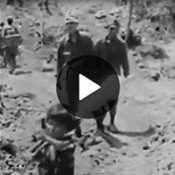
June 22, 2017 Ryukyu Shimpo
The Ryukyu Shimpo and Yahoo news have jointly created videos on the Battle of Okinawa and military base issues and shared them with viewers across the country. The videos are published on both Yahoo and The Ryukyu Shimpo’s websites.
It is the first time Yahoo has collaborated with a local newspaper company to create content.
In a feature story called, “Battle of Okinawa and the Aftermath”, part of Yahoo’s “Memories of the War to Keep for Future,” series, there are several videos including two videos titled “The Battle of Okinawa in Three Minutes” and “Okinawa in Five Minutes and The Expansion of Military after the War”, as well as testimonies from war survivors.
Ryukyu Shimpo and Yahoo! News joint project
http://ryukyushimpo.jp/pages/entry-514065.html
(English translation by T&CT and Sayaka Sakuma)
Go to Japanese
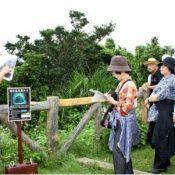
June 19, 2017 Ryukyu Shimpo
On June 18, non-profit organization Urasoe History Guide Friends’ Society conducted a tour of a bloody battlefield around Urasoe Gusuku. The tour included Maeda Escarpment, the set of director Mel Gibson’s movie “Hacksaw Ridge” in which the main character is a U.S. combat medic who saved many colleagues. Organizers say 175 people including active members of U.S. Marine Corps joined the tour.
This is the largest number of participants the Friends’ Society has had since it began tours of battlefields for the public in 2015. In the U.S., the movie was released last November. Many U.S. military officials in Okinawa have visited Maeda Escarpment since the movie’s release.
The Maeda Escarpment was where the defense line of the Japanese army was stretched to protect the 32nd Army Headquarters in Shuri, and where the Japanese military attacked the incoming U.S. Army. The U.S. military called the Maeda Highland “Hacksaw Ridge”, because it has a cliff like a saw.
The tour was divided into five groups, with five volunteer guides.
Norio Mekaru of the Friends’ Society explained that “there were many people killed in both Japanese and US forces. This place was a terrible battlefield.”
The deceased Desmond Doss, who served as a combat medic in the Battle of Okinawa and was the main character of the movie, visited Maeda in 1995. Kiyomi Tamanaha, the secretary of the Friends’ Society, pointed out to participants a location where Mr. Doss dropped a ladder.
In the former Urasoe Village, approximately 44.6 percent of the total population died in the war. The tour participants also visited Kuchigawa gama, where residents sought refuge from bombing and where dried bread food was stored. They learned about the battle in Urasoe.
A U.S. Marine Corps serviceman who visited Maeda said, “It was good that we could see various places. This way of seeing and feeling is different from reading books. If you think about the miserable situation of the past, when soldiers had to fight in this small place, it is painful.”
The film won awards in two categories (editorial and recording) at this year’s Academy Awards. “Hacksaw Ridge” was released nationwide on June 24.
(English translation by T&CT and Megumi Chibana)
Go to Japanese
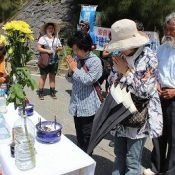
June 24, 2017 Ryukyu Shimpo
At 10:00 a.m. on July 24, in front of the gate of Camp Schwab, Henoko, Nago, a memorial service was held to mourn the loss of those who died at the former Ourasaki Camp. The camp was built in U.S. military camp Schwab immediately after the Battle of Okinawa.
About 100 people opposed to the construction of a new base that is part of the plan to relocate the Futenma airfield from Ginowan, prayed for world peace in front of a temporary altar.
It is the third memorial service to be held this year.
Takamatsu Gushiken, president of Gamafuya, a volunteer group dedicated to the recovery of human remains from the Battle of Okinawa, explained that about 400 people had died in Ourasaki, and remains had not been collected following the war.
The U.S. military housed residents from not only the northern area but also from the central and southern areas there, many among them dying of malnutrition and malaria.
(English translation by T&CT)
Go to Japanese
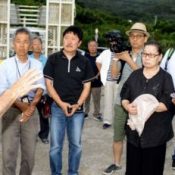
June 22, 2017 Ryukyu Shimpo
By Teppei Ikeda
In light of a Ryukyu Shimpo report revealing that fourteen military personnel and others, including Koreans, who died in an air strike by the U.S. military on a Japanese military transport ship were buried in Kenken, Motobu, members of the Battle of Okinawa remains collection volunteer group “Gamafuya”, members of a civic group calling for reparations for Koreans who were forcibly conscripted, and Motobu locals visited the burial site on June 21. Gamafuya representative Takamatsu Gushiken announced that he intends to survey the buried remains in cooperation with volunteers from South Korea and from the local area as a “Japan-South Korea amity project”. According to Masao Gabe, a relative of the landowner of the site and an emeritus professor at Yamanashi Gakuin University, the landowner plans to cooperate in the survey, and the Japanese and Korean organizations will soon begin discussions on the specifics of the survey.
A similar example can be found in the case of Shumarinai, Horokanai, Hokkaido. In 1997, a group comprising primarily youth participated in a group comprising primarily youth participated in a Japan-South Korea amity project to recover the remains of victims who were forcibly brought over as laborers from the Korean peninsula during the war and lost their lives doing dam construction, road work and other labor. In Motobu, Japanese and South Korean youth, support groups, and local people plan to use the Shumarinai case as an example and cooperate in recovery of the remains.
Gushiken explained the significance of a joint Japan-South Korea survey, saying, “We want to do whatever we can to return the remains of the deceased. Even if we don’t find any remains, it is important to endeavor to get closer to those who lost their lives. I hope we can follow the example of Japan-South Korea cooperation in Hokkaido to collect remains and thereby work to create a peaceful future.”
Twenty people participated in the visit on June 21, and local residents talked about the state of the land at the time the deceased were buried. According to the residents, the land was used by Professor Gabe’s father, also named Masao Gabe, for agriculture at the time of the burial. They explained that the land has since been elevated by roughly two meters.
Hija Lee, age 74, traveled to Okinawa from Korea. At the burial site, she spoke to the deceased, saying, “I have made you wait a long time.” She made an offering of liquor that she had brought from Korea and prayed for their happiness in the next world. “It pains me that this was not made public until it was revealed in the news,” said Lee. “I am grateful to the local people [of Motobu], and I want to work to bring the remains back home.”
The Japanese military transport ship “Hikosan Maru” was the target of U.S. military gunfire and aerial bombing on January 22, 1945.
(English translation by T&CT and Sandi Aritza)
Go to Japanese
June 22, 2017 Ryukyu Shimpo
On June 21, Okinawa Prefecture’s Department of Culture, Tourism, and Sports announced the prefecture’s tourism revenue for fiscal year 2016. The tourism revenue was 660,294,000,000-yen, a 9.6% increase from the previous year. This means that Okinawa has broken its record four years in a row. Meanwhile, expenditure per tourist was 75,297-yen, a 0.8% decrease from the previous year, which fell below the previous year’s numbers for the first time in four years. Fiscal year 2016’s numbers also did not meet Okinawa’s tourist revenue goal of 674,300,000,000-yen. Director Takao Kadekaru said, “[We] need to perform more analyses, but [we] want to work on attracting more westerners who have greater individual buying power and to lessen the difference with [on and] off-seasons.”
Expenditure per tourist decreased because of the strong yen and cruise passengers not spending as much since they do not have to arrange for accommodations. Even still, since the number of inbound tourists greatly increased, the overall revenue itself was pushed upward.
Breaking down the expenditure per tourist by type of tourist, the department found that domestic tourists spent 74,763-yen, a 0.9% increase from the previous year. Foreign tourists who traveled by air spent 98,097-yen, a 8.6% decrease from the previous year. Foreign tourists who traveled by sea via large cruise ships, spent 33,656-yen, a 29.6% increase from the previous year.
Breaking down the expenditure per tourist by how they spent their money, the department found that lodging expenses accounted for the largest expenditure. Tourists spent 22,766-yen on lodging (-1.9%), 16,711-yen (-0.5%) on food and drinks, 16,436-yen (-4.2%) on souvenirs and shopping, 10,350-yen (+0.5%) on transportation, and 6,667-yen (-4.6%) on entertainment and entrance fees.
Domestic tourists, who account for 70% of inbound tourism, stayed 2.78 days on average, which is 0.11 days shorter than the previous year’s findings. The main reason for this is that 15.3% of tourists only stayed for one night, which is a 3.3-point increase compared to the previous year.
Foreign tourists in their 20s who have relatively low spending power have also increased to 35.5%, which is a 1.9-point increase compared to the previous year.
(English translation by T&CT and Chelsea Ashimine)
Go to Japanese
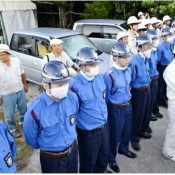
June 20, 2017 Ryukyu Shimpo
The Japanese government’s initial budget for the construction of helipads in the Northern Training Area (NTA) encompassing four helipads on three construction sites was approximately 610 million yen. However, on June 19 it came to light that in large part due to security costs, the expenses have swollen 15 times the initial amount to 9 billion 440 million yen. Tsuyoshi Kitaueda of the Peace Citizens’ Liaison Committee has publicly announced documents he procured from the Okinawa Defense Bureau (ODB) that it disclosed to him under legal obligation through freedom of information law, and that he received from House of Councillors member Mizuho Fukushima.
Although helipad construction finished in December last year, related construction such as that of entry roads still remains to be done. As such, the Japanese government has arranged for security through to the end of August. Security costs in the period just short of a year between September 15, 2016 and the end of August this year will come to 6 billion 300 million yen. That means the cost of security per day comes to about 18 million yen. Kitaueda said that it is costing the Japanese government an enormous sum to force through construction that should have remained at 600 million yen in expenses.
The originally agreed upon costs for helipad construction were 189 million yen for the N1 Zone, 252 million yen for the G Zone, and 218 million 800 thousand yen for the H Zone.
However, after the initial agreement, the ODB made contractual changes in order to “safely move construction forward.” These changes included air transport of heavy equipment by helicopters, security, temporary installments for use by security personnel, and maintenance of roads used for construction. This brought construction costs from 610 million yen to a total of 3 billion 140 million yen.
In addition to those changes, in order to deal with protest demonstrations against helipad construction, on September 15, 2016 the cost of security operations began being listed as a separate expense, no longer under construction costs. By August two security companies based in Tokyo, Shogo Security Services and Teikei, will have earned about 3 billion 147 million yen and 3 billion 158 million yen for security operations, respectively.
The ODB is currently suspending construction in observance of the Okinawa woodpecker’s nesting season from March through June. Kitaueda said: “Because landing strips have been completed, and furthermore construction is suspended, there are currently no large protest demonstrations. However, even now there are many security personnel stationed in front of the gates. The government is wasting a great sum of public funds.”
(English translation by T&CT and Erin Jones)
Go to Japanese
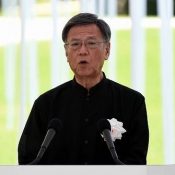
June 23, 2017 Ryukyu Shimpo
Starting at 11:50 a.m. on June 23 at Peace Memorial Park in Mabuni, Itoman City, the Okinawa Prefectural Government and Prefectural Assembly held the Okinawa Memorial Day Ceremony. This ceremony is held in memory of the more than 200,000 people who lost their lives in the Battle of Okinawa, and in pursuance of lasting world peace. During Governor Takeshi Onaga’s peace declaration, he criticized the Japanese government’s handling of the relocation of Futenma Air Station to Henoko. Onaga said that it is unacceptable that construction is being forced through regardless of Okinawans’ popular will. He encouraged Okinawans to remain unified with determined resolve in the effort to prevent construction of the new base.
Onaga pointed out the absurdity of around 70 percent of U.S. military exclusive use facilities in Japan being located in Okinawa, when Okinawa makes up only 0.6 percent of Japan’s land mass. He mentioned the crash of a US military MV-22 Osprey vertical takeoff and landing aircraft in December last year, and the continued use of a former US Navy aircraft parking apron even after a relocated parking apron was built as agreed under the Special Action Committee on Okinawa (SACO) final report. Referencing such issues, Onaga felt the need to speak up that base burden reduction is being reversed.
As a guest speaker, Prime Minister Shinzo Abe said that the existing base burden in Okinawa is intolerable. He said that in order to reduce the base burden on Okinawa the government will produce steady results one-by-one. However, he also touted the return of about 4000 hectares (15.4 square miles) of land in the Northern Training Area to Okinawa in December last year as an achievement of the Japanese government’s base burden reduction policies.
(English translation by T&CT and Erin Jones)
Go to Japanese
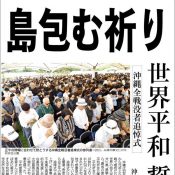
June 23, 2017 by Ryukyu Shimpo
June 23 marks the 72 year anniversary of the cessation of fighting in the Battle of Okinawa on the island. The “Battle of Okinawa War Dead Memorial Service,” (hosted by the Okinawan government and prefectural assembly) which is meant to calm the souls of the over 20,000 victims of the battle as well as to pray for everlasting peace, was held at 11:50 a.m. on the 23rd at the Okinawa Peace Park in Mabuni, Itoman, the location of the final battlefield.
From early in the morning a large number of descendants visited the peace park, touching the “Cornerstone of Peace,” on which is inscribed the names of 241,468 people, including 54 names added this year.
The memorial service was attended by four cabinet members including Prime Minister Shinzo Abe, as well as the speakers from both houses of Parliament. The observers held a moment of silence at noon.
At the memorial service Governor Takeshi Onaga read a peace declaration and railed against the absurd reality that 70% of land for U.S. military facilities was in Okinawa, calling for fundamental revisions to the Japan-U.S. Status of Forces Agreement (SOFA) and the alleviation of the over-burdening of Okinawa with regard to base-hosting by reducing the number of bases on the island. The governor also touched in the peace cornerstone that was constructed by former governor Masahide Ota, who passed away June 12, and spoke of his determination to pass on the importance of peace to later generations.
After the peace declaration, Ayane Uehara, 17, a senior at Okinawa’s Miyako High School read the peace poem, “Prayer – bringing us closer to our grandmothers.” Earlier that day at 9:00 a.m., the Okinawa Descendants Organization led a peace prayer memorial parade which left from the Itoman City Hall and converged at the memorial.
(English translation by T&CT and Sam Grieb)
Go to Japanese

April 20, 2017 Ryukyu Shimpo
Shoko, the Okinawan born model who has appeared on the cover of the Men’s fashion magazine GQ, as well as in advertisements for major corporations both domestic and foreign such as Under Armor, Star Flyer, and Toray, will be appearing in the “Orion Southern Star Summer Edition” commercial starting April 18.
This is the first time that Shoko will appear in a commercial for an Okinawan company since she debuted as a model when she was 18, over 10 years ago. “Since I was little, I always believed that I could be in the commercials that I saw on TV. Until now, even though I was taking big jobs overseas, none of my friends in Okinawa ever has the chance to see my work. This time, everyone will get a chance to see,” said Shoko, beaming with a sense of fulfillment.
Shooting took place on Sesoko Island in Motobu at the start of April. “It was very easy shooting in Okinawa’s pleasantly warm climate,” she reflected. “The music was performed by Daichi Miura, and we put together a balmy summery commercial.” She added smiling, “I hope that when people see it they say, ‘I know her.’”
(English translation by T&CT and Sam Grieb)
Go to Japanese









 Webcam(Kokusai Street)
Webcam(Kokusai Street)


